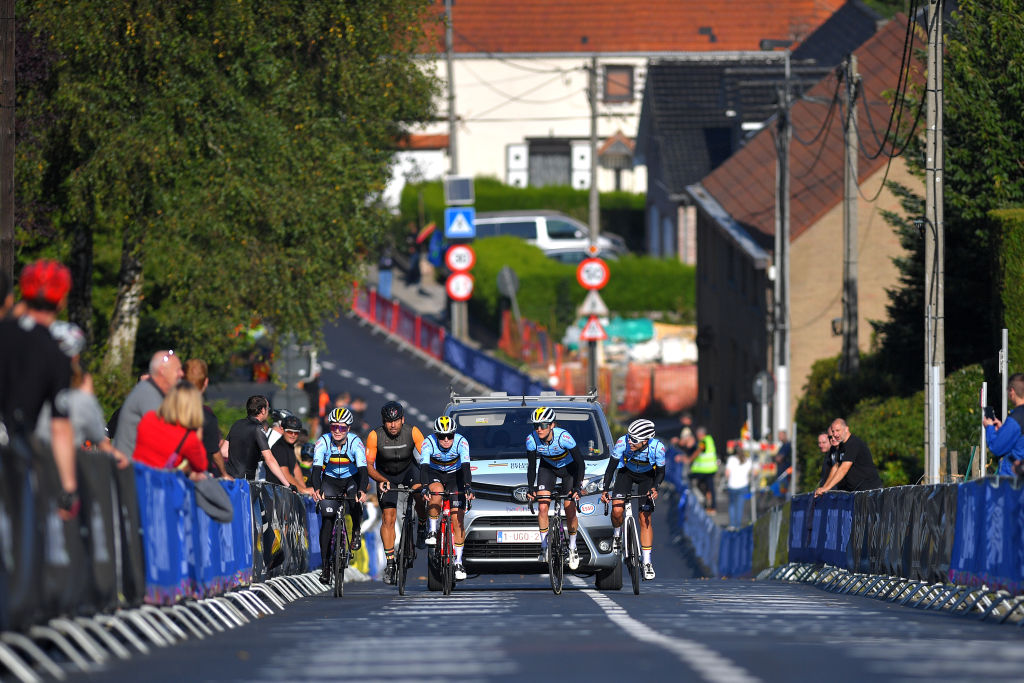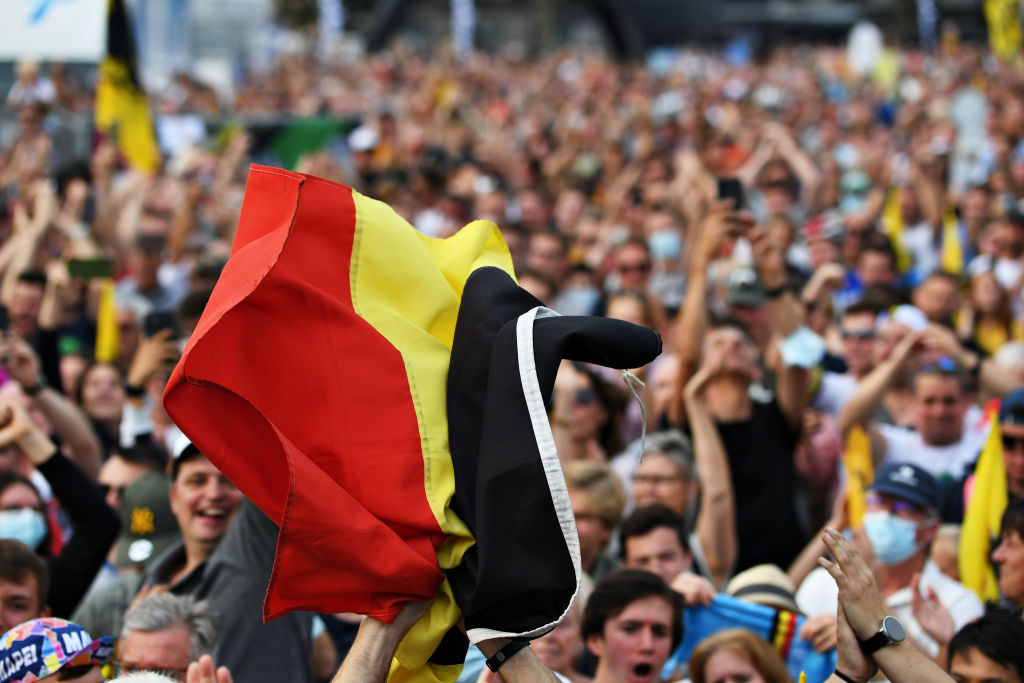An Insider’s Preview: Jolien D’hoore on the explosive parcours of the Flanders Worlds Championships
Fans can expect sharp climbs, technical circuits and thrilling finals for elite races in Flanders

The 157km elite women’s race and the 267.7km elite men's event will bring the curtain down on nine days of racing at the UCI Road World Championships in Belgium this weekend. In an interview with Cyclingnews, Ghent native Jolien D’hoore gives us an insider’s perspective of the important route details, including the decisive climbs and two technical circuits – Leuven and Flandrien – that set the stage for the final explosive days of racing in the cycling-enthusiastic region of Flanders.
“There will be a lot of spectators, really crazy, here in Belgium. The circuit is nice for the fans because there are many different points where they can see the races,” said D’hoore, who is one of the nation’s top sprinters competing in her final Worlds before retiring at the end of this season.
D’hoore will race in support of home favourite and double Belgian Champion Lotte Kopecky during the elite women’s race held on Saturday. The peloton will start at the Grote Markt in Antwerp and travel south for 55km to two distinct finishing circuits; the 15km Leuven circuit includes four climbs, and the 50km Flandrien circuit consists of six climbs.
The women’s field will first complete one-and-a-half loops of a local circuit in Leuven, followed by one loop of the main Flandrien circuit, and then two-and-a-half final loops of the local circuit in Leuven. There are 20 short climbs and a total elevation gain of 1,047 metres.The major favourites for the elite women’s race, beyond Kopecky, include Marianne Vos (Netherlands), Emma Norsgaard (Denmark), Coryn Rivera (USA), Lizzie Deignan (Great Britain), and Marta Bastianelli (Italy).
On Sunday, the elite men will start in Antwerp and follow the route 55km south to the two circuits, however, they will contest one-and-a-half laps of the Leuven loop, a lap of the Flandrien loop, then four laps of the Leuven loop, another Flandrien loop and, finally, another two-and-a-half laps of the Leuven loop. The men’s race includes 42 climbs and a total elevation gain of 2,562 metres.
Like the women’s race, the men’s route will suit versatile riders like Belgian Champion Wout van Aert and compatriot Remco Evenepoel, Julian Alaphilippe (France), Mathieu van der Poel (Netherlands), Sonny Colbrelli (Italy) and Tom Pidcock (Great Britain), who will go head to head in pursuit of the rainbow jersey.

Antwerp to Leuven: Nothing special
The races will start in Antwerp and is routed along relatively non-technical open roads before reaching the circuits in Leuven where all the action is set to take place. This section of the route could be a place for an early breakaway to form in the lengthier men’s race but D’hoore merely sees it as a warm-up for the women’s event.
Get The Leadout Newsletter
The latest race content, interviews, features, reviews and expert buying guides, direct to your inbox!
“There’s not a lot to talk about for the first part of the race, it’s mainly big roads and nothing special; no hills, no cobbles, and I think it’s going to be a nice and easy start. It’s a good warm-up for what’s coming later in the race,” D’hoore said.
Leuven preview: A criterium with climbs

- Wijnpers
- Sint-Antoniusberg
- Keizersberg
- Decouxlaan
- Wijnpers
The opening one-and-a-half laps of the Leuven circuit is the same for both the women’s and men’s fields. With fresh legs, the peloton will reach the circuit for one quick preview before heading back out to the larger Flandrien loop. They will hit the Wijnpers ascent first before reaching the four primary climbs on the short loop; Sint-Antoniusberg, Keizersberg, Decouxlaan, and Wijnpers, again, before heading out to the larger Flandrien loop.
Jolien D’hoore: The Leuven circuit is very technical with a lot of corners, up and down with short, punchy climbs, but there is not a lot of time for recovery. It will feel like a criterium with climbs in it. It will be a good circuit for explosive riders and those who can ride in front and position themselves well in the bunch. It will be good for riders who have skills.
The climbs are not selective and the longest is about one to one-and-a-half minutes, Decouxlaan. If you’re riding in the last half of the peloton then it will be a struggle because it’s much harder to ride there than at the front. You can save a lot of energy if you can stay with the first 30 or 40 riders in the group.
The first lap will be important to see how the bunch rides over those climbs and to see the circuit for the first time. The field will still be together but it will be good to see how the group corners, how they climb, and to get a feel for it. It will be good for everyone to do one loop to get a preview for the final.
Flandrien: The most decisive part of the race

- Smeysberg
- Moskesstraat
- S-Bocht Overijse - Taymansstraat
- Bekestraat
- Veeweide
- Smeysberg
The Flandrien loop include the most decisive attributes of the course for both the women’s and the men’s fields. It includes the tougher climbs over the Smeysberg and Moskesstraat and the S-Bocht in Overijse. The elite women’s road race features just one lap of the Flandrien circuit while the men will complete two laps separated by an additional lap of the shorter Leuven circuit in between.
Jolien D’hoore: This is the most decisive part of the race and similar to Brabantse Pijl, and maybe also to Amstel Gold Race, because the climbs are longer and steeper, and if it’s raced hard, it will be tough. I expect the race to start here and attacks will go on this circuit.
The two most important climbs are the Smeysberg and the Moskesstraat. They are back-to-back and they will be a hard. The Smeysberg has been newly paved and new asphalt, so it’s very smooth. It’s a long straight road and when you start the climb, you can see the top. It’s misleading because it’s really hard and steep, and some parts are over 18 per cent. It’s very steep. When you get over the top, it’s still rolling for two or three per cent for about one kilometre. That will be dangerous for attacks. Moskesstraat is cobbled and quite similar to the climbs at the Tour of Flanders. The hardest part is the last 50 metres, just before reaching the top.
The other four climbs are not that hard, with a bit of cobbles, but not too hard. The decisive moves will happen on the first two climbs.
If you were to race this circuit one time, you might think it’s not too hard, but it makes up the middle of the race for the women’s and men’s races. The way it’s raced will be super important. If you can, you can make it a hard race, it depends on the riders. I expect it to be a hard race.
It’s hard to say if the race will be won or lost on this circuit, but there will definitely be attacks on the Flandrien circuit. That said, a breakaway would also have to be able to hold it for a long time because there’s still a long way to go to the finish. A breakaway would still have the last loops on the Leuven circuit, too, with a lot of cornering and ups and downs. The race could go different ways and it’s hard to predict.
For example, in the women’s race it is 50km to go after Flandrien loop. It would be hard to ride that alone but if you look at Yorkshire Worlds where Annemiek van Vleuten attacked 100km out, then you can say it could be done here, too.
This course suits several types of riders. The Flandrien circuit is good for the more powerful climbers and the Leuven circuit is more for the sprinters, so it will be an interesting race. Is Flandrien circuit hard enough to get rid of those riders who can sprint? Think about those riders who can sprint and climb well. Marianne Vos is dangerous for this type of race.
Leuven: The grand finale
- Sint-Antoniusberg
- Keizersberg
- Decouxlaan
- Wijnpers
- Sint-Antoniusberg
The women’s and the men’s pelotons each race two-and-a-half laps, for a total of nearly 38km, along the short and technical finishing circuits. Many are predicting a reduced bunch sprint for both races, but no matter how the races unfold, there are sure to be two compelling finals in Leuven.
Jolien D’hoore: If you can save your energy during the race than you will gain so much in the end on these two final circuits. In the last 20km you will need all your energy, explosiveness, and speed on those loops. The riders with a big engines, and who have saved energy, will go far in these World Championships.

Kirsten Frattini is the Deputy Editor of Cyclingnews, overseeing the global racing content plan.
Kirsten has a background in Kinesiology and Health Science. She has been involved in cycling from the community and grassroots level to professional cycling's biggest races, reporting on the WorldTour, Spring Classics, Tours de France, World Championships and Olympic Games.
She began her sports journalism career with Cyclingnews as a North American Correspondent in 2006. In 2018, Kirsten became Women's Editor – overseeing the content strategy, race coverage and growth of women's professional cycling – before becoming Deputy Editor in 2023.